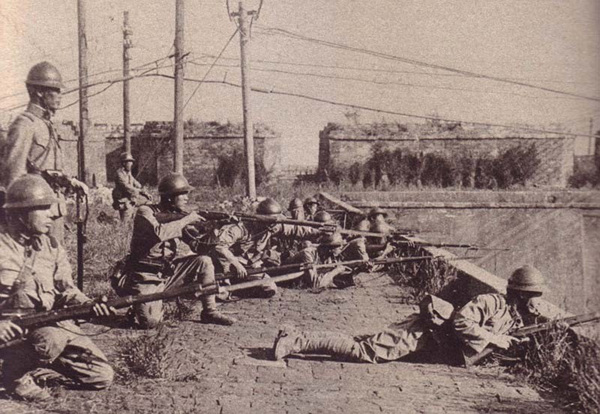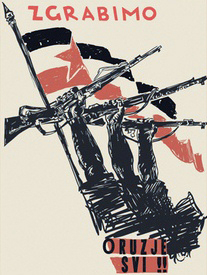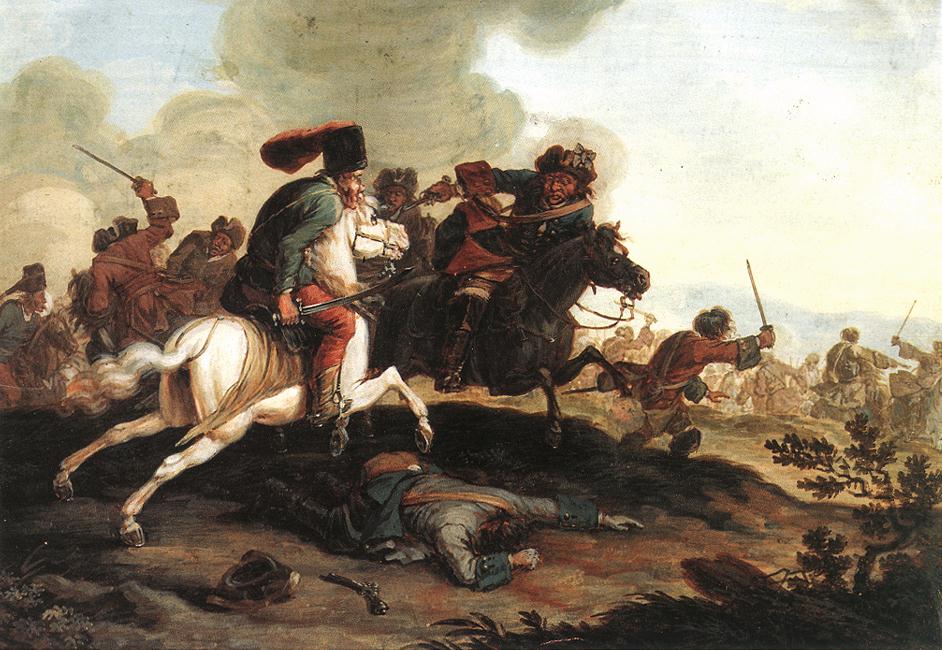|
Chinese Resistance To Japan
After the Japanese invasion of Manchuria, and until 1933, large volunteer armies waged war against Japanese and Manchukuo forces over much of Northeast China. Due to Chiang Kai-shek's policy of non-resistance, the Japanese were soon able to establish complete control. After the League of Nations refused to do more than voice its disapproval, there were many small guerrilla organizations which resisted Japanese and Manchu rule: * Jilin Self-Defence Army * Chinese People's National Salvation Army * Northeastern Volunteer Righteous and Brave Fighters * Northeastern Loyal and Brave Army * Northeast People's Anti-Japanese Volunteer Army * Northeast Anti-Japanese National Salvation Army * Northeast Anti-Japanese United Army * Heilungkiang National Salvation Army * Anti-Japanese Army for the Salvation of the Country Besides these armies there were other forces under leaders like Lao Pie-fang and others. Zhao Hong Wenguo was influential in supporting some armies such as the Iron and Blo ... [...More Info...] [...Related Items...] OR: [Wikipedia] [Google] [Baidu] |
Japanese Invasion Of Manchuria
The Empire of Japan's Kwantung Army invaded Manchuria on 18 September 1931, immediately following the Mukden Incident. At the war's end in February 1932, the Japanese established the puppet state of Manchukuo. Their occupation lasted until the success of the Soviet Union and Mongolia with the Manchurian Strategic Offensive Operation in mid-August 1945, towards the end of the Second World War. The South Manchuria Railway Zone and the Korean Peninsula had been under the control of the Japanese Empire since the Russo-Japanese War of 1904–1905. Japan's ongoing industrialization and militarization ensured their growing dependence on oil and metal imports from the US. The US sanctions which prevented trade with the United States (which had occupied the Philippines around the same time) resulted in Japan furthering its expansion in the territory of China and Southeast Asia. The invasion of Manchuria, or the Marco Polo Bridge Incident of 7 July 1937, are sometimes cited as an alternat ... [...More Info...] [...Related Items...] OR: [Wikipedia] [Google] [Baidu] |
Ma Zhanshan
Ma Zhanshan (Ma Chan-shan; ; November 30, 1885 – November 29, 1950) was a Chinese general who initially opposed the Imperial Japanese Army in the invasion of Manchuria, briefly defected to Manchukuo, and then rebelled and fought against the Japanese in Manchuria and other parts of China. Biography Early life Ma was born in Gongzhuling, in Jilin province, to a poor shepherding family. At the age of 20, he became a security guard of Huaide County. For his exceptional marksmanship and equestrianism, he was promoted to Guard Monitor of the 4th Security Guard Battalion by Wu Junsheng, Commander of Tianhou Road Patrol and Defense Battalion of Mukden, in 1908. According to some western sources, Ma Zhanshan was born in Liaoning in 1887. However, most claim 1885 as his birth year. He was of Manchu heritage and his grandson Ma Zhiwei, a member of Chinese People's Political Consultative Conference, mentioned the Manchu ethnicity of the family in his official biography and news repor ... [...More Info...] [...Related Items...] OR: [Wikipedia] [Google] [Baidu] |
Slovene Partisans
The Slovene Partisans, formally the National Liberation Army and Partisan Detachments of Slovenia, (NOV in POS) were part of Europe's most effective anti-Nazi resistance movement Jeffreys-Jones, R. (2013): ''In Spies We Trust: The Story of Western Intelligence'', Oxford University Press, p. 87/ref>Adams, Simon (2005): ''The Balkans'', Black Rabbit Books, p. 1981/ref> led by Yugoslav revolutionary communists during World War II, the Yugoslav Partisans. Since a quarter of Slovene ethnic territory and approximately 327,000 out of total population of 1.3Lipušček, U. (2012) ''Sacro egoismo: Slovenci v krempljih tajnega londonskega pakta 1915'', Cankarjeva založba, Ljubljana. million Slovenes were subjected to forced ItalianizationCresciani, Gianfranco (2004Clash of civilisations, Italian Historical Society Journal, Vol.12, No.2, p.4 since the end of the First World War, the objective of the movement was the establishment of the state of Slovenes that would include the majority of Sl ... [...More Info...] [...Related Items...] OR: [Wikipedia] [Google] [Baidu] |
Serbian Partisans
The Yugoslav Partisans,Serbo-Croatian, Macedonian, Slovene: , or the National Liberation Army, sh-Latn-Cyrl, Narodnooslobodilačka vojska (NOV), Народноослободилачка војска (НОВ); mk, Народноослободителна војска (НОВ); sl, Narodnoosvobodilna vojska (NOV) officially the National Liberation Army and Partisan Detachments of Yugoslavia, sh-Latn-Cyrl, Narodnooslobodilačka vojska i partizanski odredi Jugoslavije (NOV i POJ), Народноослободилачка војска и партизански одреди Југославије (НОВ и ПОЈ); mk, Народноослободителна војска и партизански одреди на Југославија (НОВ и ПОЈ); sl, Narodnoosvobodilna vojska in partizanski odredi Jugoslavije (NOV in POJ) was the communist-led anti-fascist resistance to the Axis powers (chiefly Germany) in occupied Yugoslavia during World War II. Led by Josip Broz Tito ... [...More Info...] [...Related Items...] OR: [Wikipedia] [Google] [Baidu] |
Macedonian Partisans
The Macedonian Partisans, officially the National Liberation Army and Partisan Detachments of Macedonia, sh, Narodnooslobodilačka vojska i partizanski odredi Makedonije was a communist and anti-fascist resistance movement formed in occupied Yugoslavia during World War II which participated in the National Liberation War of Macedonia. Units of the army were formed by Macedonians within the framework of the Yugoslav Partisans as well as other communist resistance organisations operating in Macedonia at the time and were led by the General Staff of the National Liberation Army and Partisan Detachments of Macedonia, headed by Mihajlo Apostolski. History After the Bulgarian takeover of Vardarska Banovina in April 1941, the Macedonian communists fell in the sphere of influence of the Bulgarian Communist Party. They thought that the ordinary Macedonian people believe in Bulgaria's role as liberator and that no Macedonian wants to fight against the Bulgarian soldiers. Nevert ... [...More Info...] [...Related Items...] OR: [Wikipedia] [Google] [Baidu] |
Croatian Partisans
The Croatian Partisans, officially the National Liberation Movement in Croatia ( hr, Narodnooslobodilački pokret u Hrvatskoj; NOP), were part of the anti-fascist National Liberational Movement in the Axis-occupied Yugoslavia which was the most effective anti-Nazi resistance movement Jeffreys-Jones, R. (2013): ''In Spies We Trust: The Story of Western Intelligence'', Oxford University Press, p. 87/ref>Adams, Simon (2005): ''The Balkans'', Black Rabbit Books, p. 1981/ref> led by Yugoslav revolutionary communists during the Second World War. NOP was under the leadership of the League of Communists of Yugoslavia (KPJ) and supported by many others, with Croatian Peasant Party members contributing to it significantly. NOP units were able to temporarily or permanently liberate large parts of Croatia from occupying forces. Based on the NOP, the Federal Republic of Croatia, which was referred to by Winston Churchill as "the Croatian miracle" was founded as a constituent of the Democratic ... [...More Info...] [...Related Items...] OR: [Wikipedia] [Google] [Baidu] |
Yugoslav Partisans
The Yugoslav Partisans,Serbo-Croatian, Macedonian, Slovene: , or the National Liberation Army, sh-Latn-Cyrl, Narodnooslobodilačka vojska (NOV), Народноослободилачка војска (НОВ); mk, Народноослободителна војска (НОВ); sl, Narodnoosvobodilna vojska (NOV) officially the National Liberation Army and Partisan Detachments of Yugoslavia, sh-Latn-Cyrl, Narodnooslobodilačka vojska i partizanski odredi Jugoslavije (NOV i POJ), Народноослободилачка војска и партизански одреди Југославије (НОВ и ПОЈ); mk, Народноослободителна војска и партизански одреди на Југославија (НОВ и ПОЈ); sl, Narodnoosvobodilna vojska in partizanski odredi Jugoslavije (NOV in POJ) was the communist-led anti-fascist resistance to the Axis powers (chiefly Germany) in occupied Yugoslavia during World War II. Led by Josip Broz T ... [...More Info...] [...Related Items...] OR: [Wikipedia] [Google] [Baidu] |
Soviet Partisans
Soviet partisans were members of resistance movements that fought a guerrilla war against Axis forces during World War II in the Soviet Union, the previously Soviet-occupied territories of interwar Poland in 1941–45 and eastern Finland. The activity emerged after Nazi Germany's Operation Barbarossa was launched from mid-1941 on. It was coordinated and controlled by the Soviet government and modeled on that of the Red Army. The partisans made a significant contribution to the war by countering German plans to exploit occupied Soviet territories economically, gave considerable help to the Red Army by conducting systematic attacks against Germany's rear communication network, disseminated political rhetoric among the local population by publishing newspapers and leaflets, and succeeded in creating and maintaining feelings of insecurity among Axis forces. Soviet partisans also operated on interwar Polish and Baltic territories occupied by the Soviet Union in 1939–1940, but ... [...More Info...] [...Related Items...] OR: [Wikipedia] [Google] [Baidu] |
Resistance During World War II
Resistance movements during World War II occurred in every occupied country by a variety of means, ranging from non-cooperation to propaganda, hiding crashed pilots and even to outright warfare and the recapturing of towns. In many countries, resistance movements were sometimes also referred to as The Underground. The resistance movements in World War II can be broken down into two primary politically polarized camps: the internationalist and usually Communist Party-led anti-fascist resistance that existed in nearly every country in the world; and the various fascist/anti-communist nationalist resistance groups in Nazi- or Soviet-occupied countries that opposed the foreign fascists and the communists, often switching sides depending on the vicissitudes of the war and which side of the ever-moving military front lines they found themselves on. Among the most notable resistance movements were the Polish resistance movement in World War II, Polish Resistance (including the Polish ... [...More Info...] [...Related Items...] OR: [Wikipedia] [Google] [Baidu] |
Resistance Movement
A resistance movement is an organized effort by some portion of the civil population of a country to withstand the legally established government or an occupying power and to disrupt civil order and stability. It may seek to achieve its objectives through either the use of nonviolent resistance (sometimes called civil resistance), or the use of force, whether armed or unarmed. In many cases, as for example in the United States during the American Revolution, or in Norway in the Second World War, a resistance movement may employ both violent and non-violent methods, usually operating under different organizations and acting in different phases or geographical areas within a country. Etymology The Oxford English Dictionary records use of the word "resistance" in the sense of organised opposition to an invader from 1862. The modern usage of the term "Resistance" became widespread from the self-designation of many movements during World War II, especially the French Resistance. Th ... [...More Info...] [...Related Items...] OR: [Wikipedia] [Google] [Baidu] |
Chinese Communist Party
The Chinese Communist Party (CCP), officially the Communist Party of China (CPC), is the founding and One-party state, sole ruling party of the China, People's Republic of China (PRC). Under the leadership of Mao Zedong, the CCP emerged victorious in the Chinese Civil War against the Kuomintang, and, in 1949, Mao Proclamation of the People's Republic of China, proclaimed the establishment of the People's Republic of China. Since then, the CCP has governed China with List of political parties in China, eight smaller parties within its United Front (China), United Front and has sole control over the People's Liberation Army (PLA). Each successive leader of the CCP has added their own theories to the Constitution of the Chinese Communist Party, party's constitution, which outlines the ideological beliefs of the party, collectively referred to as socialism with Chinese characteristics. As of 2022, the CCP has more than 96 million members, making it the List of largest political parties ... [...More Info...] [...Related Items...] OR: [Wikipedia] [Google] [Baidu] |
Insurgent
An insurgency is a violent, armed rebellion against authority waged by small, lightly armed bands who practice guerrilla warfare from primarily rural base areas. The key descriptive feature of insurgency is its asymmetric warfare, asymmetric nature: small irregular forces face a large, well-equipped, regular military force State (polity), state adversary. Due to this asymmetry, insurgents avoid large-scale direct battles, opting instead to blend in with the civilian population (mainly in the countryside) where they gradually expand territorial control and military forces. Insurgency frequently hinges on control of and collaboration with local populations. An insurgency can be fought via counter-insurgency warfare, as well as other political, economic and social actions of various kinds. Due to the blending of insurgents with the civilian population, insurgencies tend to involve considerable violence against civilians (by the state and the insurgents). State attempts to quell ins ... [...More Info...] [...Related Items...] OR: [Wikipedia] [Google] [Baidu] |








